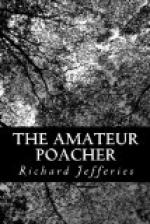There were plenty in the double-mounds to which we had access; but the shepherd, who had learned his craft on the Downs, said that the nuts grew there in such immense quantities as determined us to see them. Sitting on the felled ash under the shade of the hawthorn hedge, where the butcher-birds every year used to stick the humble-bees on the thorns, he described the route—a mere waggon track—and the situation of the largest copses.
The waggon track we found crossed the elevated plains close under and between the Downs, following at the foot, as it seemed, for an endless distance the curve of a range. The slope bounded the track on one side: on the other it was enclosed by a low bank covered with dead thorn thickly entangled, which enclosed the cornfields. The space between the hedge and the hill was as far as we could throw one of the bleached flints lying on the sward. It was dotted with hawthorn trees and furze, and full of dry brown grass. A few scattered firs, the remnants of extinct plantations, grew on the slope, and green ‘fairy rings’ marked it here and there.
These fairy rings have a somewhat different appearance from the dark green semicircles found in the meadows and called by the same name: the latter are often only segments of circles, are found near hedges, and almost always either under a tree or where a tree has been. There were more mushrooms on the side of the hill than we cared to carry. Some eat mushrooms raw—fresh as taken from the ground, with a little salt: to me the taste is then too strong. Of the many ways of cooking them the simplest is the best; that is, on a gridiron over wood embers on the hearth.
Every few minutes a hare started out of the dry grass: he always scampered up the Down and stopped to look at us from the ridge. The hare runs faster up hill than down. By the cornfields there were wire nettings to stop them; but nothing is easier than for any passer-by who feels an interest in hares and rabbits, and does not like to see them jealously excluded, to open a gap. Hares were very numerous—temptingly so. Not far from where the track crossed a lonely road was a gipsy encampment; that swarthy people are ever about when anything is going on, and the reapers were busy in the corn. The dead dry thorns of the hedge answered very well to boil their pot with. Their tents, formed by thrusting the ends of long bent rods like half-hoops into the turf, looked dark like the canvas of a barge.
These ’gips’—country folk do not say gipsy—were unknown to us; but we were on terms with some members of a tribe who called at our house several times in the course of the year to buy willow. The men wore golden earrings, and bought ‘Black Sally,’ a withy that has a dark bark, for pegs, and ‘bolts’ of osier for basket-making. A bolt is a bundle of forty inches in circumference. Though the women tell fortunes, and mix the ‘dark man’ and the ‘light man,’ the ‘journey’




